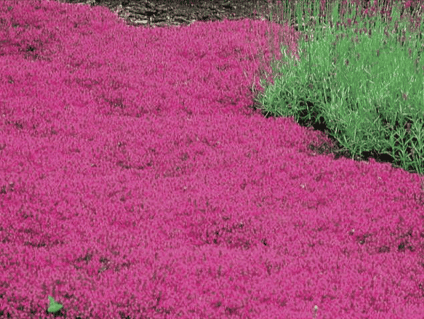Page Contents:
How to Grow and Care for Creeping Thyme
Creeping thyme (Thymus serpyllum) is a hardy, low-growing perennial that is beloved for its fragrant foliage, delicate flowers, and versatility in the landscape. This plant, also known as mother-of-thyme or wild thyme, offers a robust, earthy aroma and can serve both culinary and ornamental purposes.
Ideal for borders, walkways, rock gardens, or as a ground cover, creeping thyme enhances any garden with its charming appearance and practical benefits.
In this guide, we’ll explore the best practices for growing and caring for creeping thyme, ensuring it thrives in your garden.
How to Choose the Right Location
Keep in mind Sunlight Requirements
Creeping thyme thrives in full sun, requiring at least six hours of direct sunlight each day. Adequate sun exposure is crucial for the health of the plant, encouraging dense growth and vibrant blooms. While it can tolerate partial shade, the plants might not be as robust or produce as many flowers.
Soil Conditions
This plant is not particularly fussy about soil types; however, it performs best in well-draining soil with a neutral to slightly alkaline pH. Before planting, it’s beneficial to work some compost into the soil to improve drainage, especially if your garden has heavy clay soil.
Planting Creeping Thyme
The ideal time to plant creeping thyme is during the spring after the last frost has passed, or in early fall. This timing allows the plant to establish itself before the extreme weather of summer or winter.
When planting Creeping Thyme you should keep the following 3 things in mind.
1. Your Planting Technique
To plant creeping thyme, dig holes that are spaced about 6 to 12 inches apart, depending on how quickly you want it to cover the area. The holes should be just deep enough for the root balls. Press the soil gently around the roots after placing each plant in its hole. Water thoroughly after planting to settle the soil around the roots.
2. Ongoing Maintenance
To keep your plants healthy you must periodically engage in ongoing maintenance. This involves:
Watering – Creeping thyme is drought tolerant once established, but it will need regular watering during the first growing season to help it establish a strong root system. Once mature, watering can be reduced, and the plant will only need water during prolonged dry spells.
Fertilizing – This plant generally does not require frequent fertilization. A light application of a balanced, slow-release fertilizer at the beginning of the growing season can help promote lush growth. Avoid over-fertilizing, as this can lead to excessive foliage growth at the expense of flowering.
Pruning – This isn’t strictly necessary but trimming the plants back after flowering can encourage a bushier growth and prevent the center of the plants from becoming woody. This also helps maintain an attractive appearance and promotes healthy, dense growth.
3. Landscape Uses and Benefits
Creeping thyme is an excellent choice for ground covers, between stepping stones, in rock gardens, or along border fronts. It can tolerate light foot traffic, which makes it perfect for planting between pavers or in a patio area. The flowers attract pollinators such as bees, adding to the biodiversity of your garden.
Addressing Common Challenges
Creeping thyme is relatively resistant to pests and diseases. However, poor drainage can lead to root rot, so ensure the soil is well-draining. Occasionally, aphids can be a problem; these can be managed with a strong jet of water or insecticidal soap.
Ongoing weed control is essential, especially in the first year of growth. Mulching around the plants can help suppress weeds and retain soil moisture.
Frequently Asked Questions
1. Can creeping thyme be used in cooking like other thymes?
Yes, creeping thyme leaves can be used in cooking similar to other varieties of thyme. It is perfect for adding to meats, stews, and soups, providing a subtle, earthy flavor.
2. How fast does creeping thyme spread?
Creeping thyme spreads at a moderate pace, filling in spaces within a couple of seasons. It can spread around 18 inches in a growing season under ideal conditions.
3. Is creeping thyme evergreen?
Creeping thyme is evergreen in mild climates but may experience some dieback in colder regions during winter. It generally bounces back in spring.
4. How do I propagate creeping thyme?
Creeping thyme can be easily propagated by division or stem cuttings. Simply divide the plant in early spring or late fall, or take stem cuttings during the growing season to root and plant elsewhere.
Growing and caring for creeping thyme is a delightful way to enhance your garden with minimal effort. Its aromatic presence, beautiful blooms, and practical uses make it a must-have for any gardening enthusiast. By following the above guidelines, you can ensure your creeping thyme not only survives but thrives.












